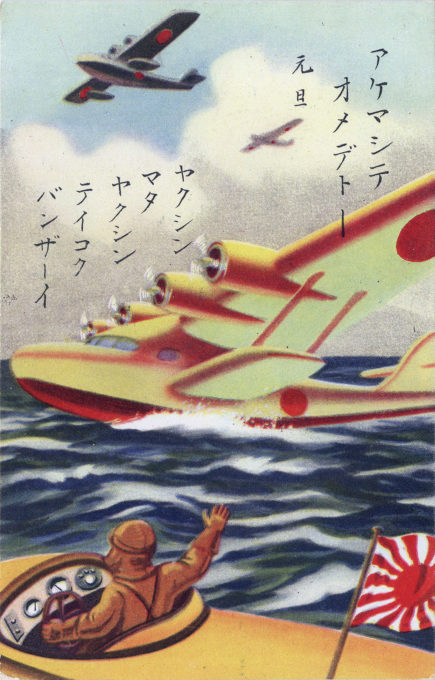
A Kawanishi flying boat decorates a New Year’s postcard, c. 1940. In addition to the traditional New Year’s greeting, Akemashite omedetou, there is also written: Yakushin mata / Yakushin teikoku / Banzai, roughly translating to “Making rapid progress toward the Imperial empire”. The flying boat was the principal type of aircraft used to connect the South Seas mandates to the Home Islands due to the shortage of flat land available for airfields. Imperial Japanese Airways began some commercial flights in 1935; regular commercial flights were begun in 1940 and a regular service commenced in 1941.
See also:
South Pacific Mandates (Japan), c. 1930.
“The islands of all sizes that constitute Japan Proper stretch like a bow. The silvery planes flying between Japan and the Palau (Pelew) Islands via Saipan suggest so many arrows shot from a bow … At a time like the present when a trans-Pacific air route is pregnant with political and economical significance, it is most important for Japan to develop her South Sea airline.
“… If the Pacific were to be divided into two spheres of influence between Japan and America, Jaluit would certainly constitute the eastern gateway to the East Asian sphere.
“In April, 1939, the four-engined Kawanishi Big Flying-Boat with accommodations for 17 passengers shuttled 2,500 miles between Yokohama and Palau over the ‘Black Current’ … The distance between Japan Proper and its ‘life-line’ in the South Seas is now covered in two days, planes plying twice a month.
“Intercourse between islands under Japanese mandate had hitherto been very inconvenient. The establishment of an air route in this part of the world marked an epoch in the history of intercourse between islands, as well as between Japan Proper and the islands.
– “Japan’s Air Route Over the Black Current”, by Takeo Ohkuo, The Far Eastern Review, July 1941

